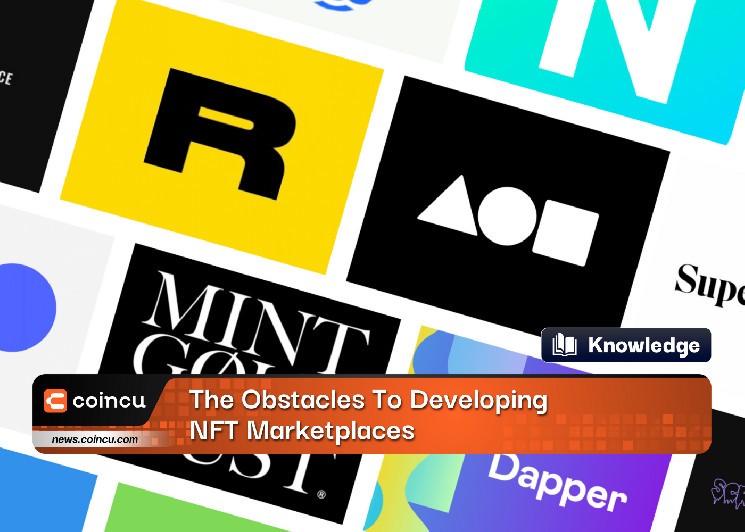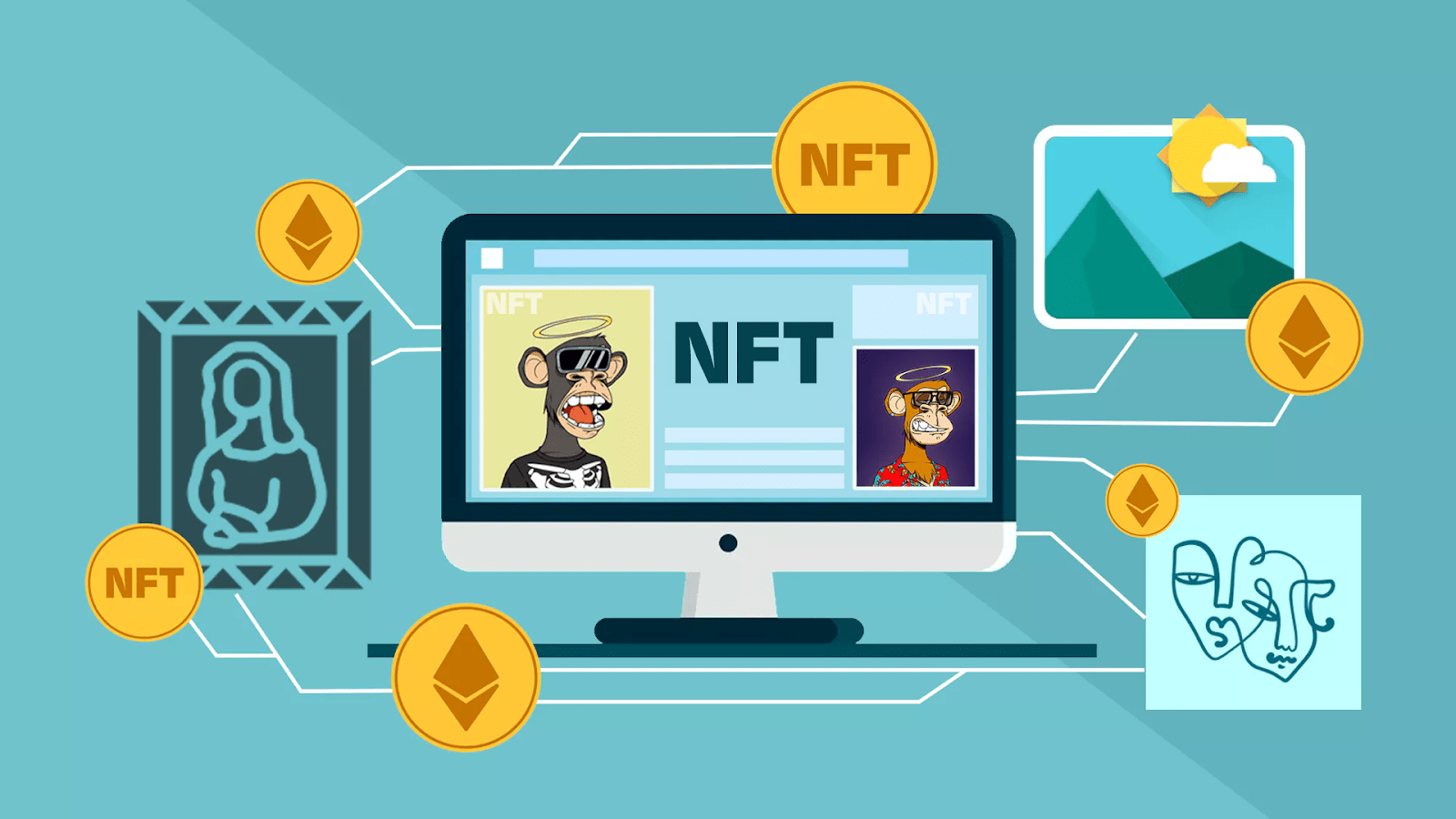The Obstacles To Developing NFT Marketplaces

The global NFT market is expected to grow at a compound annual growth rate (CAGR) of 35.0% from USD 3.0 billion in 2022 to USD 13.6 billion by the end of 2027. OpenSea is currently the largest NFT marketplace for various token types. Other well-known NFT art galleries include Nifty Gateway, Solanart, and SuperRare.
Because the NFT industry is expanding and more people want to work in it, the numbers are expanding as well. However, developing an NFT marketplace is not a simple process that necessitates knowledge, experience, and a thorough understanding of the niche. This is why many marketplaces have failed recently – they were not prepared to begin development.
This guide was created in collaboration with our tech specialists, who described the most common issues that businesses face when developing an NFT marketplace. This guide will assist anyone considering development because you will understand the issue with NFTs in 2022 and be prepared to avoid problems for a successful launch.
See Our Blockchain and NFT Development Process
NFT trades are almost always accompanied by high and hidden gas fees. And most newcomers are unaware of them. The majority of today’s NFTs are built on the Ethereum blockchain, as well as the ERC-20, ERC-721, and ERC-1155 token standards for issuing smart contracts. To be more specific, the Ethereum blockchain employs a proof of work mechanism to determine its worth. This results in high gas fees, which is one of the most significant issues with the development of the NFT marketplace today.
Inadequate User Experience
Because the industry is still in its early stages, NFT users are frequently required to search for various crypto platforms and launchpads, as well as go through lengthy sign-up and verification processes. To create a user account on some platforms, users must also provide personal information such as their government ID (KYC), phone number, and even address.
That is fine in terms of data security, but most NFT marketplaces do not offer tutorials for new users. As a result, users frequently struggle with account creation, verification, and everything else they must go through. This results in a poor user experience and forces people to seek out better solutions.

Inadequate Copyright Protection
NFTs are ideal for any artist who wishes to create digital art, fully own it, and profit from it. However, the problem stems from the fact that images and other tokens can be easily duplicated and spread across the internet without the creators’ permission. Furthermore, there is no legal framework or precedent in the NFT marketplace space to verify or reinforce the true ownership of an NFT art, as well as the following copyright evidence.
Creators suffer from a lack of creativity and expression

NFT marketplaces are designed to enable artists to sell their work and express themselves in the digital space. However, the majority of them implement numerous censorship and moderation features, limiting artists’ creativity and freedom. While this may make sense for some tokens, it may ruin the entire experience for the majority of artists who wish to use your NFT marketplace.
No Pay close attention to the user interface and user experience.
The abbreviation for User Interface is UI, and it is in charge of how users interact with your marketplace. The goal of high-quality, simple, and understandable UI is to improve and simplify the User Experience (UX). This also results in the user exerting the least amount of effort to achieve the desired result.
Because most NFT marketplaces are focused on more valuable things (in their opinion), such as verification, quick development, and protection, UX and UI are critical in determining whether your platform will be successful or not. No artist will want to use a dull and outdated interface that does not draw attention and does not make it easier for him to create tokens.
Fortunately, this problem is easily solved by assembling a professional team of designers with relevant experience. They will ensure that all elements are simple and understandable so that the user’s goal can be accomplished quickly.
Poor Customer Service
As previously stated, the NFT market is still in its early stages, and it will take time for people to learn more about its opportunities and applications. However, some business owners fail to recognize the significance of assisting their customers because they believe they are experts in this field. In reality, you never know what bugs or issues your customers may encounter while using your platform, and you are the only one who understands how it works.
This is why it is critical to provide 24-hour customer service that is always available and ready to collect all feedback and provide relevant solutions for each client. Make certain that your team will not respond with simple templates and will instead provide genuine assistance to those who require it at any given time.
Payment Options Are Limited
Modern NFT markets lack a variety of payment functions. Despite the fact that they accept payments via a variety of methods, including credit cards, debit cards, online banking, and many wallets, they do not allow users to pay in bitcoin. However, because the market is changing and people are becoming more demanding of these platforms, experts believe that this problem will be resolved soon.
Industry Confusion
Yes, NFT is a trendy term. However, this does not imply that everyone understands what it is and how it generates revenue. This is because there is so little non-technical information about NFT that it appears to be extremely confusing to the majority of people. Furthermore, most exciting marketplaces attempt to combine everything in one location, which makes it less understandable for newcomers and poorly organized. This is why it may be difficult for people to move from one category to another, select what they want, generate tokens, and manage their payments.
Cyberthreats and the Risks of Online Fraud
The enormous popularity of NFT has also increased the likelihood of cyber threats to token holders. Many hackers invent new ways to steal money from users’ accounts or, in some cases, tokens. Despite the fact that the NFT market is highly protected Due to new technological innovations and low-quality software solutions, hackers can still gain access to the platform by using three or four-step verifications.
This also occurs in large and well-established markets. There is also a high risk of someone impersonating an NFT creator and selling counterfeit art. This is due to the prevalence of fake NFT drops, airdrops, NFT giveaways, and replication of well-known NFTs.
Evaluation Difficulties
This is yet another NFT marketplace issue that users and developers face on a regular basis. Modern artists struggle to find the right price for their works because everything is dependent on a wide range of factors such as tools used, creativity, engagement, story surrounding the collection, and more.
Because the NFT market is still in its early stages, it is difficult to set a fixed price for a specific type of NFT. As a result, users frequently don’t know how to estimate their work or which criteria to use. This is why price fluctuations remain constant, making token evaluation a significant challenge.
Legal Disputes
The government has no control over the NFT market. However, countries such as the United Kingdom, Japan, and the European Union are developing their own approaches to legally classifying NFTs in order to set regulations that may be implemented soon.
This is primarily because the market is rapidly expanding and will soon become one of the largest industries in the world. As a result, the establishment of a regulatory body will become an urgent matter. Furthermore, because NFTs are now used in a variety of ways and spheres, the regulatory body will need to adapt to the rules and regulations of an exciting market that is constantly changing.
Smart Contract Risks and NFT Maintenance
Finally, one of the most challenging aspects of creating an NFT marketplace is smart contract creation and NFT maintenance. This is closely related to the threats we discussed earlier, as hackers frequently attack a Defi (Decentralized Finance) network in the hopes of stealing a large number of tokens. This is due to inadequate smart contract protection and a lack of expertise among the developers involved. This problem can be solved by hiring blockchain development experts.
Conclusion
The NFT market has expanded dramatically. As a result, most businesses began to consider the most effective way to enter this space – NFt marketplace development. However, not everyone is aware of the issues that may arise while developing this platform. We created this guide to help you understand the issue with NFTs and anticipate the challenges.
DISCLAIMER: The Information on this website is provided as general market commentary and does not constitute investment advice. We encourage you to do your own research before investing.






 Bitcoin
Bitcoin  Ethereum
Ethereum  Tether
Tether  USDC
USDC  TRON
TRON  Dogecoin
Dogecoin  Cardano
Cardano  Bitcoin Cash
Bitcoin Cash  Chainlink
Chainlink  Monero
Monero  LEO Token
LEO Token  Zcash
Zcash  Stellar
Stellar  Litecoin
Litecoin  Hedera
Hedera  Dai
Dai  Cronos
Cronos  Tether Gold
Tether Gold  OKB
OKB  Ethereum Classic
Ethereum Classic  KuCoin
KuCoin  Gate
Gate  Algorand
Algorand  Cosmos Hub
Cosmos Hub  VeChain
VeChain  TrueUSD
TrueUSD  Dash
Dash  Tezos
Tezos  Stacks
Stacks  Decred
Decred  IOTA
IOTA  Basic Attention
Basic Attention  Theta Network
Theta Network  NEO
NEO  Synthetix
Synthetix  Qtum
Qtum  Ravencoin
Ravencoin  DigiByte
DigiByte  0x Protocol
0x Protocol  Nano
Nano  Zilliqa
Zilliqa  Siacoin
Siacoin  Numeraire
Numeraire  Waves
Waves  Status
Status  BUSD
BUSD  Enjin Coin
Enjin Coin  Pax Dollar
Pax Dollar  Ontology
Ontology  Hive
Hive  Lisk
Lisk  Steem
Steem  Huobi
Huobi  NEM
NEM  OMG Network
OMG Network  Bitcoin Gold
Bitcoin Gold  Augur
Augur  HUSD
HUSD